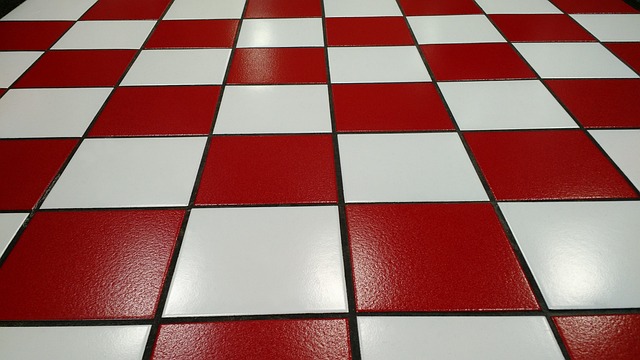Grout stains in kitchens and bathrooms are caused by moisture, dirt, oil, and foot traffic, leading to mold, mildew, and health risks. Effective removal requires understanding stain types and using eco-friendly methods like natural cleaners or enzymatic products. Traditional cleaning methods with harsh chemicals don't address root causes and can cause health issues. Natural alternatives like baking soda and vinegar are safe and effective for removing grout stains, while lemon juice and dish soap tackle tougher cases. Professional eco-friendly services offer specialized equipment and tailored products for challenging areas. Regular cleaning with baking soda paste, sealing with eco-friendly sealer, and reapplication every few months prevent future stains.
Tired of unsightly grout stains that refuse to go away? Explore eco-friendly solutions to effortlessly remove even the most stubborn marks between tiles. This comprehensive guide unveils powerful yet natural ways to tackle grout stains, from understanding their causes and types to DIY remedies and professional services. Learn how to maintain pristine, stain-free grout lines using sustainable practices. Discover the secrets to keeping your spaces fresh, clean, and green!
Understanding Grout Stains: Causes and Types

Grout stains can be a common problem, especially in high-traffic areas like kitchens and bathrooms where moisture and dirt are frequent visitors. Understanding the causes and types of grout stains is the first step in finding effective eco-friendly solutions for their removal.
Moisture, one of the primary culprits behind grout discoloration, can lead to mold and mildew growth, especially in warm, humid environments. This can result in black or green stains that not only affect aesthetics but also pose health risks. Other common causes include oil and grease from cooking, cleaning products, and even foot traffic that tracks in dirt and grime. Types of grout stains vary from surface-level discoloration to deeper penetration, with solutions varying accordingly. Surface stains can often be treated with natural cleaners like baking soda and vinegar, while more entrenched stains may require eco-friendly, enzymatic-based products designed specifically for grout.
Traditional Cleaning Methods and Their Drawbacks

Traditional cleaning methods often rely on harsh chemicals and abrasive tools to remove grout stains, which can be detrimental to both the environment and your health. These conventional approaches may temporarily mask the issue but fail to address the root cause, leading to recurring stains. The use of toxic chemicals in close proximity to your home or workplace can also pose significant risks, causing respiratory problems and skin irritation for those exposed.
Furthermore, standard cleaning solutions may not be as effective in removing deep-seated stains or addressing the build-up of dirt, grime, and bacteria within grout lines. These drawbacks highlight the need for eco-friendly alternatives that are both safe and powerful enough to remove stains without compromising the integrity of your space.
Natural and Eco-Friendly Alternatives for Stain Removal

When it comes to eco-friendly grout stain solutions, there are several natural alternatives that prove effective in removing unsightly marks from your tile work. Many conventional cleaning products contain harsh chemicals that can be damaging to both the environment and your health, making natural remedies a more sustainable choice.
One popular option is using baking soda and vinegar, a classic combination that cuts through grease and grime while being gentle on surfaces. For grout lines in particular, this mixture can be applied directly, left to soak for a few minutes, then scrubbed gently with an old toothbrush or grout brush. Another natural cleaner worth considering is lemon juice, which acts as a mild acid to dissolve mineral deposits and stains without leaving behind harsh residue. Simply apply fresh lemon juice to the stained area, let it sit, and rinse thoroughly. These simple, green alternatives not only keep your home clean but also contribute to a healthier planet.
DIY Grout Stain Solutions You Can Try at Home

Removing stains from grout lines can be a challenging task, but there are several DIY solutions that you can try right at home. Many conventional cleaning products contain harsh chemicals that may damage your tile or leave behind harmful residues. Fortunately, natural alternatives are both effective and safe for your home environment.
One popular method involves using a mixture of baking soda and vinegar. This powerful duo can cut through grease, grime, and even mold stains. Simply sprinkle baking soda along the grout lines, then pour white vinegar over it to create a fizzing reaction. Let the mixture sit for about 15 minutes, and the stain should start to lift. For more stubborn stains, you can add a bit of lemon juice or a drop or two of dish soap to enhance cleaning power.
Professional eco-friendly grout cleaning services: When to consider them

Professional eco-friendly grout cleaning services are an excellent option for those looking to maintain their tile work while minimizing environmental impact. These services utilize advanced techniques and natural cleaning agents to effectively remove stains from grout lines, ensuring your space remains both aesthetically pleasing and sustainable.
Consider hiring a professional when the stains are stubborn or widespread, or if you lack the time or expertise to perform an eco-friendly cleaning yourself. Professional cleaners have access to specialized equipment and products designed specifically for grout care, making them more efficient and effective at removing dirt, mold, and other debris without resorting to harsh chemicals. This is particularly important in high-traffic areas where regular maintenance can be challenging.
Preventing Future Stains: Tips for Maintaining Eco-Friendly Grout

To prevent future grout stains and keep your eco-friendly grout looking fresh, regular cleaning is key. Start by sweeping or vacuuming your tiles regularly to remove loose dirt and debris that could stain the grout. Next, use a mixture of baking soda and water to create a natural cleaning paste, which can be applied directly to the grout lines. This simple solution effectively removes existing stains while keeping your space looking clean and green.
Additionally, sealing the grout after cleaning is essential. Apply an eco-friendly grout sealer using a soft cloth, following the manufacturer’s instructions. This barrier protects against water, mold, and mildew, preventing new stains from setting in. Remember to reapply the sealer every few months, especially after intense cleaning or exposure to harsh conditions, to maintain optimal protection for your grout lines and remove stains efficiently.
